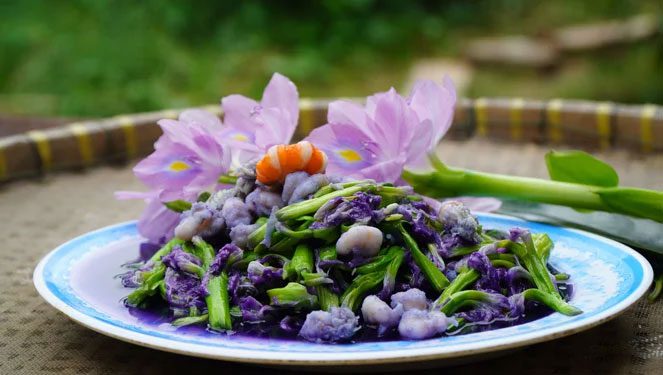This plant is used for various purposes, but its health benefits are not widely known.
Dr. Huỳnh Tấn Vũ, from the University of Medicine and Pharmacy Hospital in Ho Chi Minh City (Branch 3), states that water hyacinth (Eichhornia crassipes), also known as lotus flower, water lily, or Japanese water hyacinth, is an aquatic plant, herbaceous, floating in water, belonging to the genus Eichhornia in the family Pontederiaceae.
Water hyacinth was introduced to Vietnam, originally from the Amazon River basin, and is a species of warm-water aquatic plant.
According to Dr. Vũ, water hyacinth is high in fiber, rich in minerals, and has low energy value. It contains various compounds such as alkaloids, phthalates, propanoids, and phenyl derivatives that have antibacterial, antifungal, antioxidant, and anticancer properties.
Raw extracts from water hyacinth and some of its compounds demonstrate antibacterial activities. The crude extract contains different antibacterial substances with varying efficacy and mechanisms that can act antagonistically or synergistically to inhibit bacterial growth.

Dishes made from water hyacinth. (Photo: ST).
According to Dr. Vũ, water hyacinth has antioxidant potential. The antioxidant activity of the active components isolated from water hyacinth may be due to the presence of hydroxyl groups.
Raw extracts from water hyacinth also show the highest effectiveness compared to all isolated compounds against various types of tumors. Water hyacinth extract exhibits very strong selective anticancer activity against liver cancer cell lines and other types of tumors.
Dr. Vũ stated: “The aforementioned effects of water hyacinth are only preliminary results from laboratory research. Applying these laboratory results to real life requires many processes. It does not mean that consuming water hyacinth will automatically yield these effects.”
Dishes and Remedies from Water Hyacinth
Dr. Vũ mentioned that based on traditional medicine practices, water hyacinth can be used as a medicinal herb. The usable parts are the leaves and the swollen part of the leaf stalk.
Water hyacinth is used externally for pain relief (boils, wounds). Method: Pick a handful of water hyacinth, wash it thoroughly, pound it, add a little salt, and then apply it to the swollen area. Change the poultice when it dries. Apply 2-3 times a day.
Applying water hyacinth helps reduce pain and swelling, making patients feel more comfortable. Clean the water hyacinth leaves, pound them finely with salt (100g of water hyacinth with 5-8g of salt), apply evenly to the swollen area, and bandage loosely to prevent moisture loss. It is advisable to apply it from the evening until the next morning.
According to Dr. Vũ, in other countries, such as Indonesia, the stems and flowers of water hyacinth are used to prepare healthy dishes. Recently, Vietnamese people have also begun to incorporate water hyacinth into various delicious recipes.
Water hyacinth shoots can be stir-fried like lotus stems. The young shoots and leaf stalks are used to cook soups with shrimp, snakehead fish, or dried shrimp. Water hyacinth flowers can be boiled and served with braised fish or stir-fried with pork or pig’s intestines, and dishes like water hyacinth and tilapia hot pot or stir-fried water hyacinth with beef or pork belly.
Dr. Vũ advises that although water hyacinth has many health benefits, it is essential to be cautious when using it and avoid harvesting water hyacinth from polluted water sources. This is because water hyacinth has the ability to absorb heavy metals and other toxins from water and accumulate them in its body. Consuming such contaminated water hyacinth poses a risk of heavy metal poisoning.
Only consume water hyacinth harvested from clean water channels and select the young shoots. Avoid eating water hyacinth frequently to prevent the accumulation of heavy metals in the body.


















































